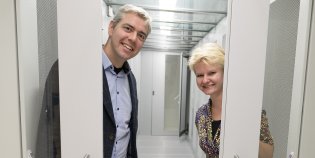KB celebrates 20 year e-Depot anniversary
It’s important for the KB that everyone in our society can participate by reading, learning and forming an opinion. That is why the KB keeps a large collection of publications from and about the Netherlands. Our repository contains many kilometres of books, newspapers and magazines, but we also store an ever growing number of digital publications. For that, we maintain an e-Depot; the repository for all digital publications managed by the KB. It now contains over 40 million publications. In December 2022 the KB celebrates the 20 year existence of its operational e-Depot.
To mark this occasion, we spoke with the KB’s head of digital preservation Jeffrey van der Hoeven and
metadata specialist for digital preservation
Susanne van den Eijkel.
What is the e-Depot?
Jeffrey: “The e-Depot is the repository for all of our digital publications. We use it to store digital books, magazines and newspapers as well as e-books. The collection ranges from the most scholarly articles to children’s books. These files are stored on servers. We now have over 40 million digital publications in the e-Depot, with thousands of publications added every day.”
Why and when was it initiated?
Jeffrey: “The KB was among the first libraries to recognise that digital publishing would become the future. We were already working on this in the late 1990s. The e-Depot was officially launched 20 years ago on 12 December 2002. It was even featured on national television. This really was groundbreaking at the time. We were the first organisation in the Netherlands to store born-digital publications on a large scale. These are publications that are digital by origin. At that time, this mostly concerned scientific journals published only in digital form by publishers such as Elsevier and Springer.”
What’s so special about the KB’s e-Depot?
Susanne: “Each country has one or more digital archives. For example, municipal archives store documents digitally, and museums also digitise material. The KB’s e-Depot sets itself apart by the nature of the collection; we preserve a variety of digital heritage. Our Collections Department often purchases special, historical items such as books and newspapers, and we digitise those as well. We also have a lot of born-digital material. And we have special web collections, such as a ‘coronavirus collection’ in which websites about the coronavirus pandemic are preserved. These are historical documents that reflect the times.”
Why is it so important to have this?
Jeffrey: “It’s about keeping information available and ‘understandable’ for current and future generations. We have done this for printed and written publications for almost 250 years, and now also for digital publications for two decades.”
Is the goal to digitise the KB’s complete physical collection?
Susanne: “Since 2018, we have had a preference for digital publications. Anything we can obtain digitally, we want to obtain digitally. So if we have a choice between a physical book or an e-book, we’ll take the e-book. Although there are exceptions to this, of course. The goal isn’t necessarily to have digital copies of everything that exists physically. But of course there are big projects like Metamorfoze and Delpher, in which a huge amount of material is being digitised. There is also the question of whether we should want to preserve everything. At the very beginning of the internet age, people printed and saved their emails, but we stopped doing that too. And maybe it’s better to be selective, also considering the environmental impact. Storing material on servers and keeping it accessible takes energy.”
Who decides what’s worth preserving?
Jeffrey: “Our Collections Department decides what criteria a publication must meet in order to be included in the repository. We no longer store all the regional newspapers in our repository, and this also applies to the e-Depot. Some of the material comes in through agreements with publishers, and some through our digital self service deposit portal, where people can deposit publications themselves."
Susanne: “We also have a Web Archive in which the KB stores the web collections we initiate ourselves, together with our colleagues from the collections department. An example is the coronavirus collection mentioned earlier.”
Can anyone access the e-Depot?
Jeffrey: “If publications are freely accessible, what’s known as open access material, you can also access it externally. But if it’s not freely accessible, you can only view it in the reading rooms in the KB building, when you’re a KB member. Material from our e-Depot is also accessible through certain services, such as Inter Library Loans (ILL) or Delpher.”
What does the future hold?
Jeffrey: “What we’re seeing is that the method of publishing is changing tremendously, and it’s going to change even more. For example, newspapers are increasingly read via apps or websites, e-books are here to stay, and social media are becoming more and more important. In addition, the number of publications and file formats continues to increase. This poses a great challenge for the future.
The KB is preparing for this increase in scale. We are currently storing about 2,000 terabytes of material and expect this to increase to about 4,500 terabytes by 2027.
We have established a policy outlining what we do to properly care for our digital collections. We ensure that we have the proper technology that enables us to store files in the correct way and place. And we employ people with expertise, who can take good care of the material. We work on this with a team of about 30 people. We’re continuously working on our ability to preserve everything in the repository for future generations.”
Susanne: “It is our responsibility to keep digital material accessible for the long term. That means we want to keep digital collections authentic, and understandable, so that future generations also comprehend how digital objects should be read. At the same time, we have to be realistic and I think it’s naive to believe that everything should be preserved forever.”
Read on
National library of the Netherlands receives CoreTrustSeal for its e-Depot

Dutch National Library steps into a new future of digital archiving

Expert Judith Rog



